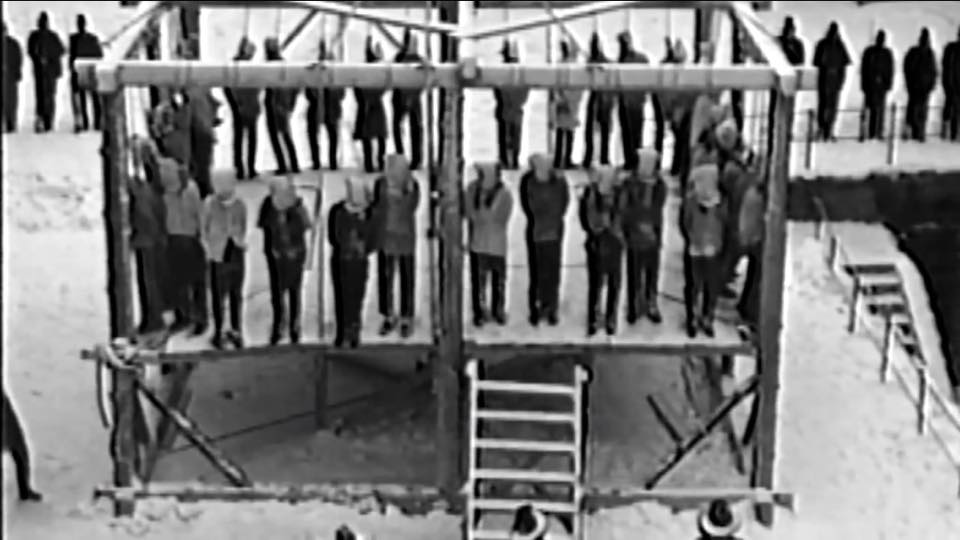Why Celebrating Columbus (Day) is Celebrating THEFT and GENOCIDE:
Read these 9 cases of American Crime for the truth about Columbus and America
| revcom.us
Bob Avakian has written that one of three things that has “to happen in order for there to be real and lasting change for the better: People have to fully confront the actual history of this country and its role in the world up to today, and the terrible consequences of this.” (See “3 Things that have to happen in order for there to be real and lasting change for the better.”)
Every year, on the second Monday in October, America celebrates “Columbus Day,” heralding Christopher Columbus as a great explorer who “discovered” the “New World” and made the creation of the United States possible. Columbus didn’t discover America, but he did bring conquest and enslavement. And he launched one of the most massive genocides in human history, a genocide whose scale and savagery still boggle the mind, as these installments of our American Crime series focused on Native Americans illustrate. This, along with the enslavement of Black people, is what sits at the foundation of the United States.
See all the articles in this series.
Case #77: Christopher Columbus Brought Genocide and Slavery to the "New World," and America Celebrates Him for It
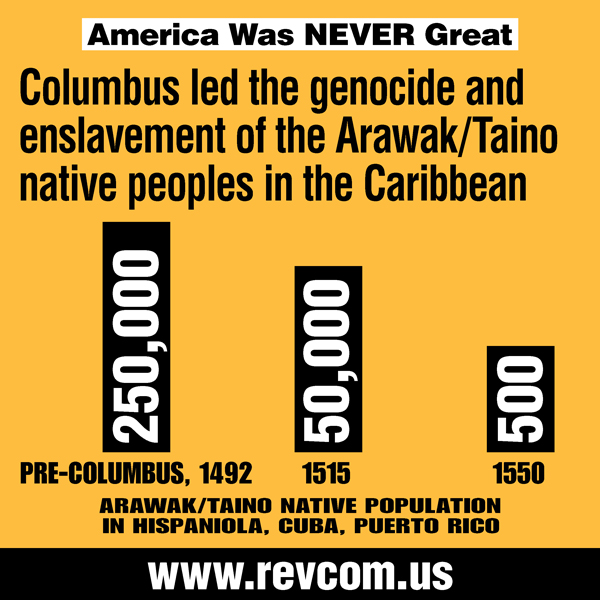
THE CRIME: On October 12, 1492, Christopher Columbus, an Italian sailing for Spain, landed on what is now the Bermuda Islands. Columbus is celebrated in the U.S. as the person who first “discovered” the “New World,” making it possible for those who came after him, through hard work, to create the greatest global power in the world today, as the official declaration of “Columbus Day” as a national holiday states.
Columbus did not “discover” the Americas—they had been inhabited by many different indigenous peoples for some 13,000 years. But he did bring conquest and enslavement, and launched one of the most massive, horrific genocides in human history.
Case #90: The Sullivan Expedition, 1779—Genocide of Native Peoples and Scorched Earth in Upstate New York
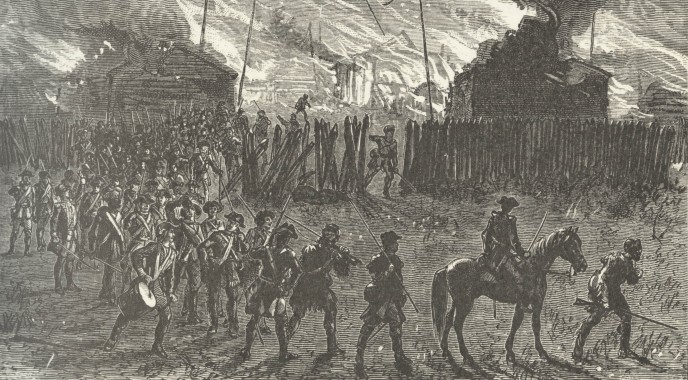
THE CRIME: In June 1779, heavily armed caravans of more than 6,200 American soldiers headed north from Pennsylvania and west from a town near Albany, New York. These forces, under the command of General John Sullivan, comprised about 25 percent of the Continental Army, which had been formed by the Continental Congress of former colonies that were in a war for independence from England.
Their target: Native American tribes who lived in western New York—the Mohawk, Oneida, Onondaga, Tuscarora, Cayuga, and Seneca peoples. These peoples called themselves the Haudenosaunee, and are known to historians as the Iroquois League or Iroquois Confederacy. The mission of Sullivan’s troops: the “total destruction and devastation of their settlements, and the capture of as many prisoners of every age and sex as possible,” in the words of the commander in chief of the Continental Army.
Case #44: The Trail of Tears, 1838-39
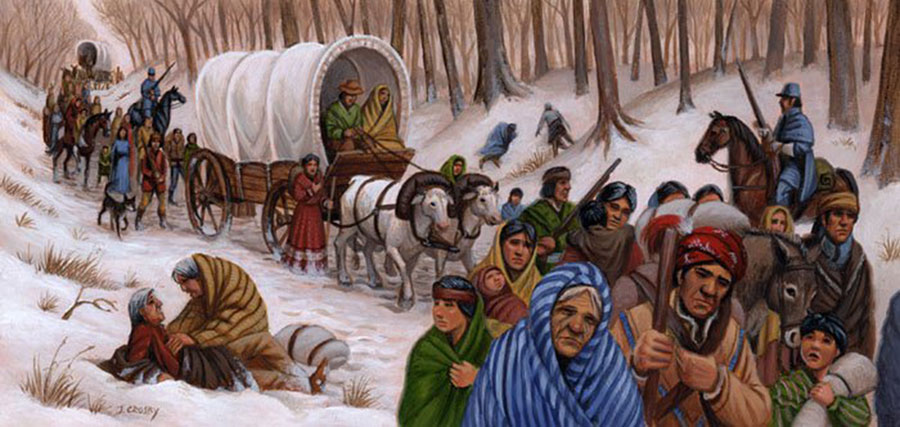
Trail of Tears
THE CRIME: From 1838-1839, approximately 15,000 Cherokee and 2,000 Black slaves that they owned were forcibly removed from Cherokee lands in Georgia and force-marched by the military 800 miles to the new “Indian Territory” in an area that later became Oklahoma. On that march, it has been estimated that 2,500-4,000 people died. That seven-month march has become known as The Trail of Tears.
This brutal and forced removal of the Cherokees is just one part of what should be known about the Trail of Tears. The Trail of Tears is actually the removal of five “civilized” tribes from their native lands in Southeastern U.S. to the West: the Choctaws from Mississippi, the Seminoles from Florida, the Chickasaw from Tennessee, the Creek from Alabama, and the Cherokees from Georgia.
Case #53: The Genocide of California's Native Americans, 1846–1873
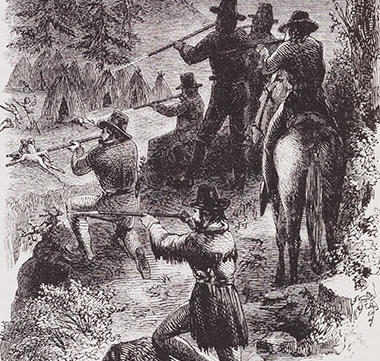
THE CRIME: From 1846 to 1873, a mass genocide was carried out against California’s Native American population by the U.S. government and white settlers. In 1846, before the 1848 Gold Rush, 157,000 people were living in California, 150,000 of them Native Americans. It was the densest and most diverse Native American population in the U.S. By 1873, there were only 30,000 Native Americans left alive, and by 1880, only 16,277.
This massive ethnic cleansing was the result of the genocidal murders of the native population at the hands of U.S. soldiers, volunteer state militiamen, and vigilantes. This included large massacres that wiped out entire villages, group killings, individual killings, the starvation of thousands, and the death of thousands due to diseases while imprisoned in U.S. Army forts or on federal Indian reservations.
Case #37: December 26, 1862: The Lynching of 38 Dakota Men―The Largest Mass Execution in U.S. History
THE CRIME: On December 26, 1862, in the midst of the U.S. Civil War (April 1861-May 1865), and in the same week that the Emancipation Proclamation was issued, President Abraham Lincoln ordered 38 Dakota Santee Sioux men sent to the gallows in Mankato, Minnesota. They were hooded and hanged simultaneously from a single scaffold, surrounded by 1,500 Union troops and a howling lynch mob of 4,000 white settlers. It was the largest mass execution in U.S. history.
Case #56: The 1864 Sand Creek Massacre
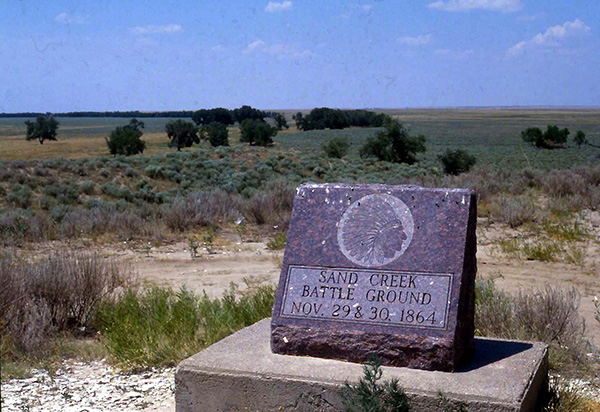
The site of the Sand Creek Massacre. Photo: Wikimedia Commons
THE CRIME: They came at dawn, November 29, 1864, 700 heavily armed soldiers of the 3rd Colorado Cavalry, led by Colonel John Chivington. They rode rapidly toward their target, a Cheyenne village near Sand Creek, where the people were caught by surprise because months earlier, representatives of the U.S. government had met with their chief, encouraged him to settle near the creek, and had promised him and his people peace and safety. As the soldiers approached, the chief, Black Kettle, raced to raise the American flag over his lodge in a show of solidarity; others raised white flags of surrender. It didn’t matter.
The soldiers opened fire with carbines and cannons, killing at least 130, almost two-thirds women, children, and the elderly. Most of the young men were out hunting when the attack occurred; otherwise, the death toll would have been considerably higher. Before leaving, the soldiers burned the village and mutilated the dead.
Case #72: Wounded Knee Massacre, 1890
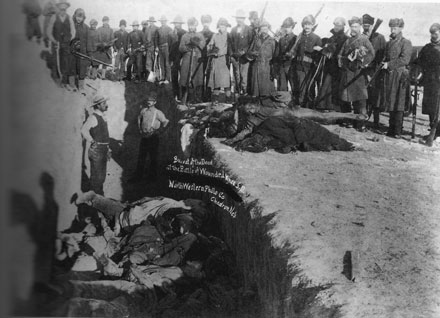
Photo: Library of Congress
THE CRIME: On December 29, 1890, U.S. government soldiers massacred nearly 300 of the 350 Lakota men, women, and children on the Pine Ridge Indian Reservation in South Dakota. The massacre took place near Wounded Knee Creek. Some of the women murdered were already widows whose husbands had previously been killed by U.S. troops. The Lakota Chief Spotted Elk (Big Foot), who was dying of pneumonia, was among those massacred.
Case #64: The U.S. Conquest of Hawai`i
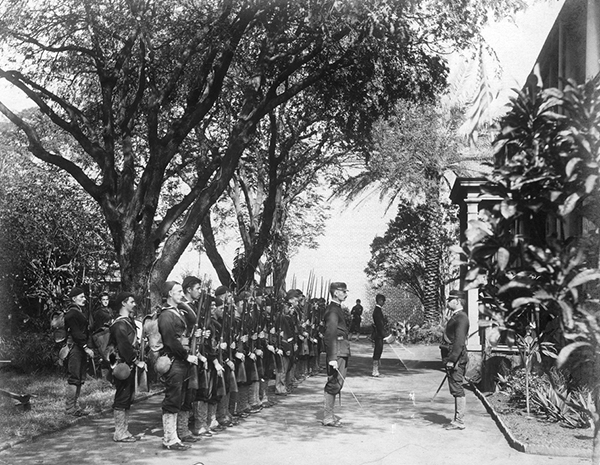
Marines marched from the USS Boston to I'olani Palace as part of taking over the Hawai’ian government.
THE CRIME:
The Overthrow: On January 17, 1893, 162 armed U.S. sailors and Marines marched from the USS Boston, harbored in Honolulu Harbor, to Iolani Palace, the center of Hawai’i’s government, and set up camp. This act of war against a nation struggling for independence from foreign domination put the U.S. firmly in control.
Lorrin Thurston, the grandson of an American missionary who had the support of Hawai`i’s white business class, had organized a coup d’etat. And the U.S. had agreed to provide military back up. Thurston’s core conspiracy group, which included Hawai`i’s powerful sugar barons, joined the “Honolulu Rifles” a heavily armed militia of 1,500 largely white businessmen, who patrolled the streets to put down any Native Hawaiians who might rebel.
Case #40: North American Indian Residential Schools, 1870-1970s: “Kill the Indian, Save the Man”
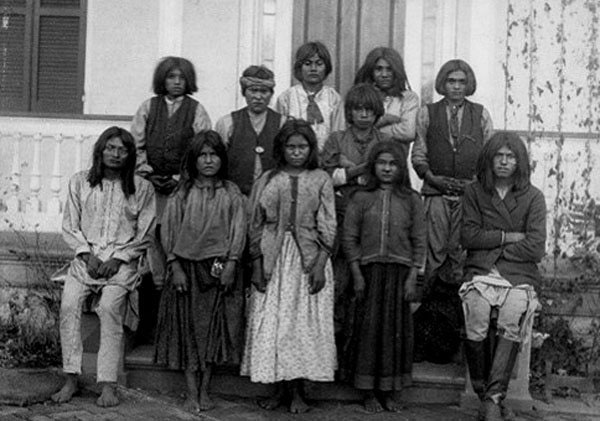
Native Americans from an Apache tribe entering Carlisle School in 1890.
THE CRIME: The cultural genocide of the North American Indians.
The near extermination of the Native Americans in the centuries following 1492 is one of the great historical crimes committed by the rulers of this country—or any country. Credible estimates of the indigenous population in North America in 1492 are between 12.5 and 18.5 million. Through the combination of massive epidemics and the “Indian Wars” waged by the U.S. Army through the decades after the Civil War, by 1890 the estimated Native American population had been reduced to fewer than 240,000 in the U.S., and in Canada a third of that—a population reduction of 95 to 99 percent.
Beginning in the 1870s and lasting a century or more, the weight of U.S. policy toward the Native American population shifted from military annihilation to the forced “assimilation” of the survivors—making them “suitable” to be members of the society that had devastated and despised them.
Get a free email subscription to revcom.us:



